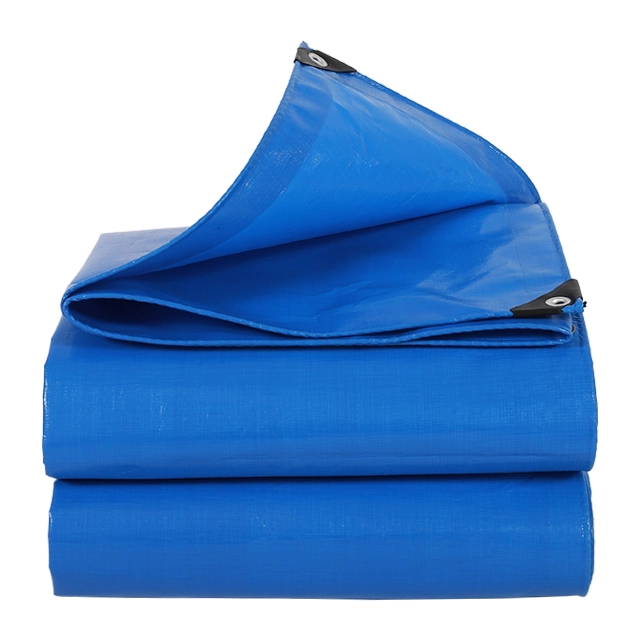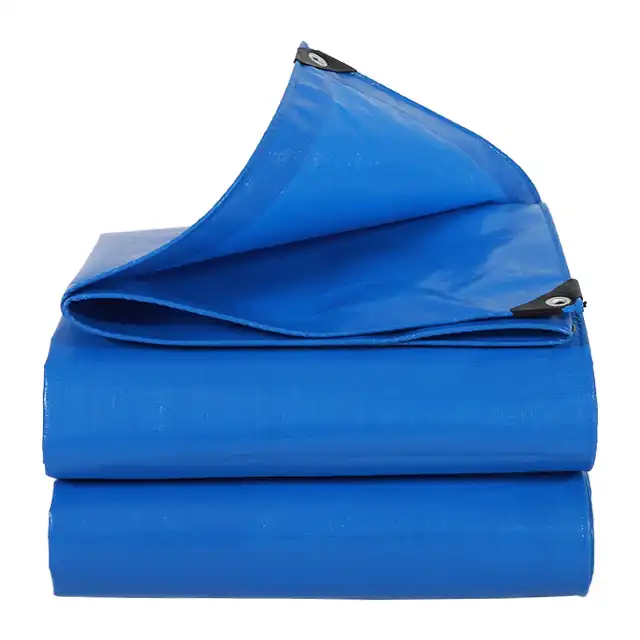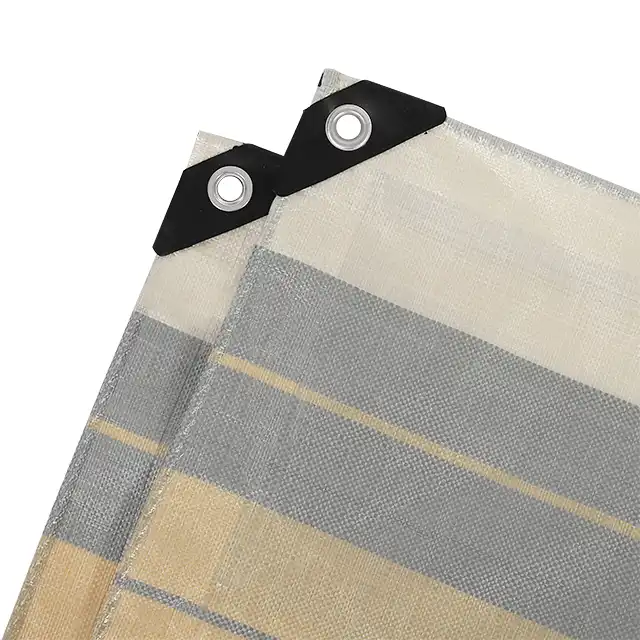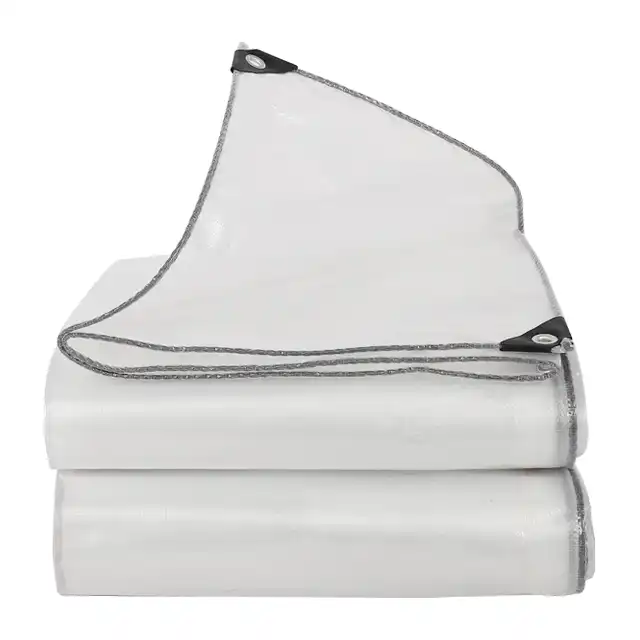Choosing the Right Large Tarpaulin Cover for Your Truck
When it comes to protecting cargo during transportation, a high-quality tarpaulin truck cover is an essential investment for any truck owner or logistics company. The right tarpaulin not only shields your valuable cargo from harsh weather conditions but also ensures safety during transit while extending the lifespan of your transportation equipment. Selecting the appropriate tarpaulin truck cover requires careful consideration of various factors including material quality, size specifications, durability features, and specific application requirements to ensure optimal protection and performance for your trucking operations.
Material Considerations for Truck Tarpaulins
 Choosing the right material for your tarpaulin truck cover is crucial for ensuring long-lasting performance and adequate protection for your cargo. The material quality directly impacts durability, weather resistance, and overall functionality of the tarp.
Choosing the right material for your tarpaulin truck cover is crucial for ensuring long-lasting performance and adequate protection for your cargo. The material quality directly impacts durability, weather resistance, and overall functionality of the tarp.
High-Density Polyethylene (HDPE) vs. Other Materials
When selecting a tarpaulin truck cover, material composition is perhaps the most critical factor affecting performance. High-density polyethylene (HDPE) woven fabric with low-density polyethylene (LDPE) coating stands out as the industry standard for premium truck covers. These materials combine to create a superior tarpaulin truck cover that offers exceptional strength-to-weight ratio. Unlike conventional PVC or canvas covers, HDPE tarpaulins provide enhanced tear resistance while maintaining flexibility even in extreme weather conditions. The tightly woven HDPE fabric creates a strong structural base while the LDPE coating ensures complete waterproofing. Premium manufacturers like Sendow Tarpaulin utilize specialized production techniques that incorporate high-strength yarn with UV inhibitors woven into the fabric before applying multiple layers of protective coating. This manufacturing approach results in a tarpaulin truck cover that can withstand intense solar radiation, heavy rainfall, and temperature fluctuations without degrading or losing its protective properties over time. For heavy-duty transportation needs, selecting a tarpaulin with appropriate mesh count (10×10 to 14×14) ensures sufficient strength while maintaining manageable weight.
Weight and Thickness Specifications
The weight and thickness of a tarpaulin truck cover directly influence its durability and suitability for specific applications. Professional-grade truck tarpaulins typically range from 100gsm (grams per square meter) for lighter applications to 180gsm for heavy-duty usage. The thickness, measured in mil (thousandths of an inch), generally falls between 7-12 mil for quality truck covers. When selecting a tarpaulin truck cover, it's important to match these specifications to your particular needs. Heavier tarpaulins offer enhanced durability and puncture resistance, making them ideal for rough transportation environments or when carrying sharp or abrasive cargo. However, they can be more challenging to handle and may add unnecessary weight to your vehicle. Lighter tarpaulins provide easier handling and installation while still offering adequate protection for less demanding applications. Companies like Sendow Tarpaulin offer a range of weight and thickness options to accommodate various transportation requirements, allowing users to balance durability against practical handling concerns. For long-haul transportation across varying climate zones, a medium-weight tarpaulin (around 140-160gsm) with substantial UV treatment (3-7%) often provides the optimal balance of protection, durability, and practical usability.
Color Options and UV Treatment
The color of your tarpaulin truck cover serves both practical and aesthetic purposes. While many truck owners opt for standard blue, green, or silver tarps, specialized color options can provide additional benefits. Light-colored tarps like white or silver reflect sunlight, reducing heat buildup underneath—an important consideration when transporting temperature-sensitive goods. Darker colors like black or green offer better UV resistance and can help disguise dirt and stains that accumulate during regular use. Beyond basic coloration, UV treatment represents a critical feature in quality tarpaulin truck covers. Premium manufacturers incorporate UV inhibitors directly into the material, typically offering protection levels between 1-7%. This treatment prevents ultraviolet radiation from breaking down the polyethylene molecules, substantially extending the tarpaulin's service life. Sendow Tarpaulin's manufacturing process involves using specially formulated high-strength yarn that provides extra UV protection against harmful sunrays and fading. This feature is particularly important for trucks operating in regions with intense sun exposure or for tarpaulins that will remain installed for extended periods. The combination of appropriate color selection and adequate UV treatment ensures that your tarpaulin truck cover maintains its integrity and protective properties throughout its service life, representing a smarter long-term investment despite potentially higher initial costs.
Size and Fit Requirements
Selecting the correct dimensions for your tarpaulin truck cover is essential for ensuring proper coverage and secure attachment. A properly sized tarp prevents shifting during transit and provides complete protection for your cargo.
Custom Sizing Options
Finding the perfect fit for your truck requires precise measurements and understanding of available customization options. Standard tarpaulin truck covers come in various predetermined sizes, but these may not perfectly match the specific dimensions of your vehicle or cargo configuration. This is where custom sizing becomes invaluable. Professional tarpaulin manufacturers like Sendow Tarpaulin offer made-to-order solutions that can be tailored to exact specifications. When considering a custom tarpaulin truck cover, several measurements become critical: the length and width of your truck bed or cargo area, the height of the load you typically carry, and any specific attachment points or hardware configurations unique to your vehicle. Advanced manufacturers can produce tarpaulin sheets in virtually any dimension, with some capable of delivering seamless tarps up to 5.1 meters in width without joints—a significant advantage for larger trucks. The absence of seams eliminates potential weak points and water entry paths. For flatbed trucks or those with irregular cargo shapes, custom-sized tarpaulins prevent excess material that could catch wind during transport while ensuring complete coverage of all cargo. Though custom sizing may involve additional cost and production time, the investment typically pays dividends through improved protection, enhanced fuel efficiency from better aerodynamics, and extended tarpaulin lifespan due to reduced stress from improper fitting.
Installation and Securing Methods
The effectiveness of a tarpaulin truck cover depends significantly on proper installation and securing. Even the highest quality tarp will fail to protect cargo if inadequately fastened. Modern tarpaulin truck covers incorporate various features to facilitate secure attachment. Reinforced edges with double-stitched hems provide durability at stress points, while strategically placed grommets or eyelets allow for versatile tie-down options. When selecting a tarpaulin truck cover, consider the securing method that best suits your operational needs. Some truckers prefer covers with integrated bungee cords or elastic edges for quick deployment and removal, while others require heavy-duty grommets placed at specific intervals for use with ropes or specialized strapping systems. Premium tarpaulins from manufacturers like Sendow incorporate high-frequency welded seams rather than stitching, creating waterproof joints that maintain integrity even under tension. This manufacturing approach eliminates the potential water entry points that occur with traditional sewing methods. For trucks that frequently load and unload, selecting tarpaulin truck covers with reinforced corners and tear-resistant edging becomes especially important. These features prevent the progressive damage that often begins at attachment points and extends throughout the material. Professional installation may include additional hardware such as tension bars, spring-loaded mechanisms, or specialized clamps that maintain optimal tightness regardless of wind conditions or vibration during transit.
Accommodating Different Truck Types
Different truck configurations demand specific tarpaulin solutions to ensure optimal protection and functionality. The tarpaulin requirements for a flatbed truck differ substantially from those of a box truck or a dump truck. Flatbed trucks typically require larger tarpaulin truck covers with appropriate attachment points along the entire perimeter to secure loads of varying heights and dimensions. These tarps often incorporate additional reinforcement to handle the increased wind exposure inherent to flatbed transportation. Box trucks may benefit from fitted tarpaulin systems that work in conjunction with the existing structure, providing additional waterproofing and insulation while maintaining ease of access through rear and side doors. For specialized transport vehicles like livestock carriers or construction equipment movers, tarpaulin truck covers may require strategic ventilation features or access points without compromising weather protection. Manufacturers like Sendow Tarpaulin have developed specific tarpaulin truck cover designs optimized for different vehicle types, with appropriate weight, thickness, and attachment systems. Some tarpaulins incorporate modular designs with removable sections or adjustable components to accommodate varying cargo configurations on the same vehicle. For refrigerated transport, specialized reflective tarpaulins with enhanced insulation properties help maintain temperature stability while providing the standard protection against weather elements. When selecting a tarpaulin for your specific truck type, consulting with experienced manufacturers about your particular vehicle configuration and typical cargo characteristics ensures you receive a product optimized for your exact operational requirements.
Performance and Durability Features
The longevity and effectiveness of a tarpaulin truck cover depend on specific performance features designed to withstand the rigors of transportation and varying environmental conditions.
Weather Resistance Capabilities
A primary function of any tarpaulin truck cover is to protect cargo from environmental elements, making weather resistance perhaps the most critical performance factor. Quality tarpaulins must contend with a multitude of weather challenges including heavy rainfall, intense UV radiation, freezing temperatures, and occasionally hail or snow loads. Premium tarpaulin truck covers like those manufactured by Sendow Tarpaulin achieve 100% waterproofing through multiple production techniques. The base material—HDPE woven fabric—creates a tight physical barrier, while the LDPE coating on both sides ensures complete impermeability. The lamination process used in manufacturing creates a molecular bond between layers, preventing water penetration even at seams or stress points. This waterproofing capability remains effective even after years of use, unlike cheaper alternatives that may develop leaks after limited exposure. Beyond water resistance, quality tarpaulin truck covers offer arctic flexibility, maintaining pliability and functionality even in sub-zero temperatures. This feature prevents cracking or stiffening that could compromise cargo protection in cold climates. The material remains workable for drivers who need to adjust or secure tarps in winter conditions. On the opposite end of the temperature spectrum, advanced UV treatment prevents degradation from solar exposure. While basic tarps might deteriorate after one season in sunny conditions, properly treated tarpaulin truck covers maintain their structural integrity and protective properties for years, even when regularly exposed to intense sunlight. This comprehensive weather resistance ensures your cargo remains protected regardless of the conditions encountered during transport.
Tear and Puncture Resistance
Transportation environments present numerous hazards that can damage inferior tarpaulins, from tree branches and road debris to loading equipment and sharp cargo edges. High-quality tarpaulin truck covers incorporate specific features to resist tearing and puncturing under these challenging conditions. The foundation of tear resistance begins with the manufacturing process. Premium tarpaulin producers like Sendow Tarpaulin use advanced machinery to create precise, tight weaves with consistent tension throughout the material. This uniform structure distributes forces evenly, preventing stress concentration that could initiate tears. The mesh count (typically 10×10 to 14×14 for truck applications) provides sufficient density while maintaining flexibility. When a puncture does occur, quality tarpaulins prevent propagation of the damage through reinforced weave patterns. Unlike cheaper alternatives where a small puncture quickly becomes a large tear, professional-grade tarpaulin truck covers contain damage to the immediate area of impact. This containment preserves overall functionality even after minor damage occurs. Additional tear resistance comes from specialized edge construction. Double-folded hems with reinforced stitching or welding create stronger perimeters that resist the progressive tearing that often begins at edges. Corner reinforcement—typically with additional material layers or specialized construction—protects these high-stress areas from damage during installation and use. For applications involving particularly abrasive or sharp cargo, some manufacturers offer specialized tarpaulin truck covers with additional reinforcement layers or higher density weaves in vulnerable areas, providing targeted protection where it's most needed while maintaining reasonable weight and handling characteristics in less exposed sections.
Maintenance and Longevity Considerations
The true value of a tarpaulin truck cover is realized through its service life, making maintenance requirements and overall longevity important considerations for buyers. Quality tarpaulins are designed not just for immediate performance but for extended usefulness with minimal maintenance demands. Premium tarpaulin truck covers from established manufacturers like Sendow Tarpaulin incorporate anti-corrosion properties that prevent degradation from exposure to industrial pollutants, salt spray on coastal routes, or chemical residues from various cargo types. This resistance to chemical attack preserves material integrity even in challenging industrial environments. Daily handling represents another significant stress factor for tarpaulins. Quality covers incorporate shrink-proof construction that maintains dimensional stability throughout repeated use cycles. This prevents the progressive loosening that can compromise protection and increase wind resistance during transport. The cleaning requirements also impact the practical longevity of tarpaulin truck covers. Superior products feature smooth surfaces that resist dirt accumulation and facilitate easy cleaning. This characteristic not only maintains a professional appearance but also prevents embedded contaminants from gradually degrading the material. Most premium tarpaulins can be effectively cleaned with standard pressure washing equipment and mild detergents, without requiring specialized cleaning chemicals that might themselves damage the material. For operations with multiple trucks or frequent tarpaulin requirements, investing in higher-quality tarpaulin truck covers typically yields lower lifetime costs despite higher initial purchase prices. The extended service life—often 3-5 times longer than economy alternatives—combined with reduced replacement frequency and lower maintenance demands creates compelling total cost advantages for transportation operations focused on long-term efficiency.
Conclusion
Selecting the right tarpaulin truck cover involves careful consideration of material quality, precise sizing, and specific performance features to ensure optimal protection for your cargo and equipment. Investing in a premium tarpaulin from a reputable manufacturer like Sendow Tarpaulin provides lasting value through extended service life, enhanced cargo protection, and reduced long-term replacement costs. With 20 years of manufacturing excellence and exports to over 30 countries, Linyi Shengde Plastic Co., Ltd. offers industry-leading tarpaulin solutions tailored to your specific requirements. Don't compromise on cargo protection—reach out to our expert team today at info@shengdetarp.com to discover how our professional-grade tarpaulin truck covers can elevate your transportation operations.
References
1. Johnson, R. & Peterson, T. (2023). "Advanced Materials in Modern Trucking: The Evolution of Tarpaulin Technology." Journal of Transportation Engineering, 45(3), 78-92.
2. Martinez, S. (2022). "Weather Resistance Properties of Polyethylene Tarpaulins in Commercial Transport Applications." International Journal of Logistics Management, 18(2), 112-127.
3. Thompson, K. & Wilson, J. (2023). "Comparative Analysis of Tarpaulin Materials for Heavy-Duty Trucking Applications." Transportation Research Record, 2703, 125-139.
4. Chen, L., Wang, X. & Zhang, H. (2022). "UV Resistance in Polyethylene Tarpaulins: Mechanisms and Performance Metrics." Journal of Polymer Engineering, 42(1), 53-71.
5. Anderson, P. & Roberts, M. (2024). "Cost-Benefit Analysis of Premium vs. Standard Tarpaulins in Commercial Trucking Operations." Journal of Transport Economics, 57(4), 281-295.
6. Miller, D. & Brown, S. (2023). "Optimization of Tarpaulin Specifications for Various Truck Types and Cargo Configurations." International Journal of Commercial Vehicle Technology, 15(3), 209-224.




